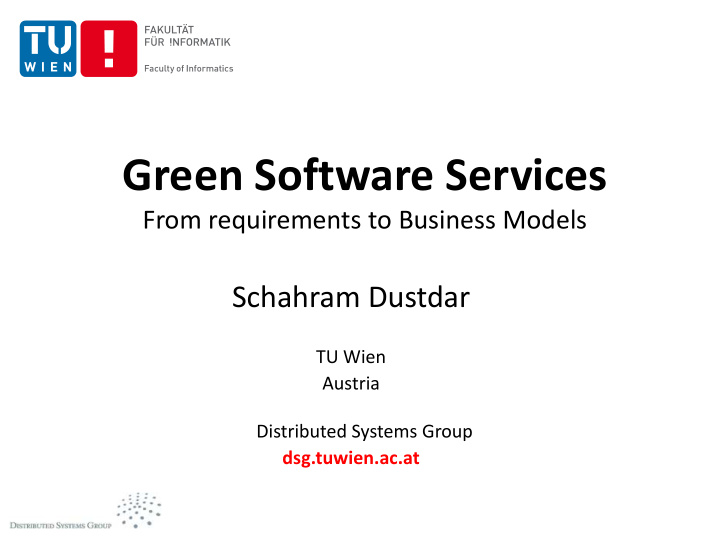



Green Software Services From requirements to Business Models Schahram Dustdar TU Wien Austria Distributed Systems Group dsg.tuwien.ac.at
Smart rt Evoluti ution on – People, e, Services, ces,Th Things ings Smart eGovernments & Smart Buildings eAdministrations and Energy Networks Elastic Systems eHealth & Smart Health Smart networks Game Machine DVC STB Homes TV Smart Transport PC Networks Audio DVD Telephone
S. Dustdar, H. Truong , “ Virtualizing Software and Humans Computing Models for Elastic Processes in Multiple Clouds – a Service Management Perspective”, in International Journal of Next Generation Computing , 2012 Machine-based Human-based Computing Things-based computing Computing Processing Unit Ad hoc networks Web of things Architecture SMP Grid Comm.
Autonomic Nervous System
Organic System – Everything connected
Airports, ports and Critical Infrastructure Government Sector Hospitality Sector Healthcare Sector Utilities and Smart Grid Datacenters Power Street Light Environment Lighting Industrial Sector Access control Food Transfer Transport Sector Education Sector Finance Sector Quality Control Management Compliance Control Process Ubiquitous Managed Services Solution Across Business Verticals Incidents Data CCTV Algorithm Event Predictive Blackbox manager mining KIOSK Chart engine Facilities Open Monitoring Public Safety Industrial Parking HealthCare mgmt Waste modeling module builder Monitoring integration Control process Control Service Management FDD platform Regression Expert rule Resource Mgmt parameters GUI engine engine mgmt. Database builder Storage Point Portfolio Location manger Integration Resource policies metering Operations Mgmt awareness Analyics Numerous Forms Of Smart Services.. framework manager framework manager engine Controls Transaction Mgmt. Provisioning Managed services • • Activation • Services Visibility • Portfolio management • • Deactivation • SIM profile Billing • Event management • Privacy • configuration Reporting • Analytics • • Security Network configuration IoT and Cloud Computing enable smart services ecosystem and collaboration opportunities More than 7 billion devices and sensors exist for M2M application
ICT for energy Command Control Center savings in buildings
ICT enabled Security Services Command Control Center Saudi Command Control Center Shopping malls Hospitals Schools Airports Factories
ICT enabled Telematics Command Control Center Vehicle tracking system Logistics Management
ICT enabled services for food storage and delivery Command Control Center Cold storage system Food display cabinets Freezer rooms
ICT enabled services for health care Command Control Center Hospital equipments monitoring Hospital security systems Hospital operations management
ICT enabled smart education systems Command Control Center Smart classrooms Campus infrastructure Smart Universities management
Monitoring
Chiller Plant Analysis Tool
Integration Presentation Service Providers Third Party Application Developers Energy Analysis Fault Detection Continuous Facilities & Diagnostics Commissioning Management Measurement & Dashboards & Verification Reports End Users Maintenance Carbon Footprint Analysis Management & GHG Accounting OEM Asset Performance Alarm Management Management ICT Network Enterprise Application Database Vehicle Temperature Security System Tracking Sensor AHU Device SIM Cameras Pressure Sensor Vehicle Tracking KW System Meter Occupancy Chillers KW Sensor Flow Meter Power Meter Humidity Smoke Fire Alarms Meter Detector Sensor ATMs Boilers Signage HVTS FAHU Generators Pumps UPS
Command Control Center for Managed Services
Smart City Stakeholders
Core Stakeholders • Business Service Providers – Operate business utilizing GSS – Common objectives e.g., maximizing sustainability of their business -> impacting their business financials • OEMs – Produce equipment (source of energy consumption) – Their efforts have significant impact on savings (e.g., via energy saving capabilities)
Core Stakeholders /2 • GSS providers – Provide services to Business service providers – GSS retain service interfaces – Establish direct business relationsships with customers who need GSS • GSS developers – Implement business logic and optimization methods -> significant impact – Domain knowledge required
Supporting Stakeholders • Governments – Are responsible for large scale sustainability activities and information providers – Policy making and enforcement, legislation, standards • Auditors – Systematically assess GSS – Provide baseline for comparing (future) GSS – Standardized evaluation methods • Service Consumers – Currently “passive“, however, behavior patterns help to get data and improve GSS
Service delivery platform for Smart Cities
Service delivery workflows
Some GSS Requirements /1 1. Identifying Core Services – Collecting/Preparing data from target systems (access & acquire raw+higher level data) – Customizing for different target systems – Accomodating various scales -> Elasticity
Elasticity ≠ Scaleability Quality elasticity Resource elasticity Non-functional parameters e.g., Software / human-based performance, quality of data, computing elements, service availability, human multiple clouds trust Elasticity Costs & Benefit elasticity rewards, incentives
Some GSS Requirements /2 2. Supporting Process optimization & analytics – Data modeling & simulation, Context-aware controls, agent based systems 3. Supporting of sustainability policies – Modeling & understanding policies of target systems – Finding efficient ways for meeting goals 4. Ensuring Privacy & Security – Securing controls for privacy & security 5. Supporting stakeholder collaborations – Building interfaces and marketplaces for collaborations
Business Models
Infrastructure Services
Platform Services
Virtual Vertical
Data Services
3rd party applications
Analytics as a Service
First Conclusions • GSS require tight integration from Requirements, Design & Implementation, to the Business Models • Understanding & Support for Stakeholders needed (Data, Elasticity, collaboration models) • Cloud service models and GSS collaboration models needed
Some Research Challenges /1 • Virtual Verticals – Dynamic number of devices – Various (amounts of) real-time data – Ad hoc application usage on Clouds • Cross-layer planning methodologies needed – Providing an isolated environment per tenant – Dynamic resources (Elasticity) • Coherent model for scheduling/predicting resource usage – Impact on Elasticity
Some Research Challenges /2 • Programing Model – Inherent in PaaS – Decoupling applications from device specifics – Control logic often executed in Gateways -> standardization issues • Quality-aware real-time data – Data quality is highly volatile – Data quality assurance is needed -> methods e.g. statistical, selective data sources, etc. • Metering, Billing, and SLA – Needs support for all resources and various contexts – Metering & Billing for all stakeholders -> Configurability
Thanks for your attention Forthcoming paper: IEEE Internet Computing 2013 Schahram Dustdar Distributed Systems Group TU Vienna - Austria - Europe dsg.tuwien.ac.at
Recommend
More recommend